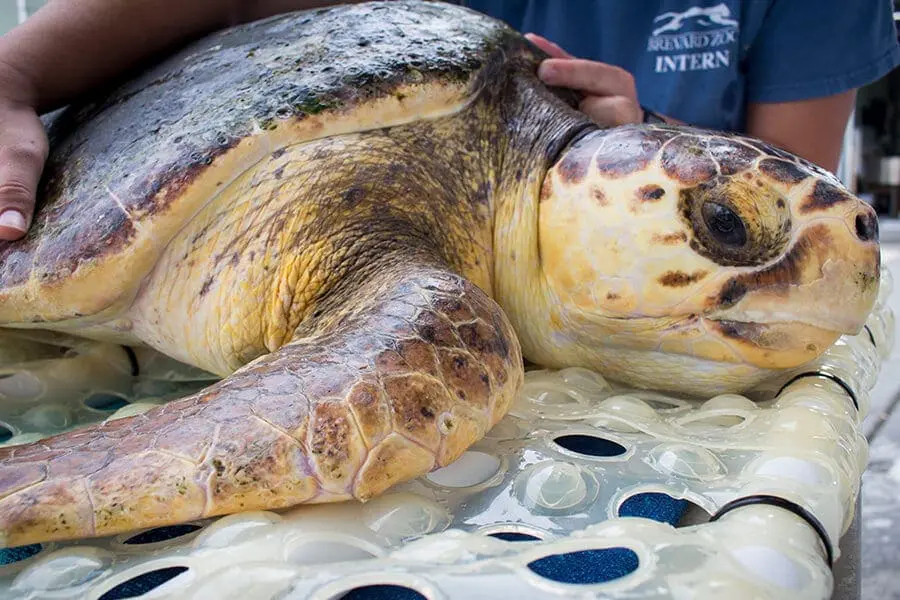

Humbug, a loggerhead sea turtle, is prepared for release.
For millions of years, sea turtles have been nesting on beaches and swimming across oceans. Today on World Sea Turtle Day, we want to highlight these beautiful reptiles and encourage you to help them survive and thrive. There are six species of sea turtle in the United States, five of which are found locally:
Loggerhead
If you have ever seen a sea turtle nest on the beach, chances are it belonged to a loggerhead! This is the most common sea turtle found in and around the United States. Though they are listed as threatened under the Endangered Species Act, they are the only sea turtle species not listed as endangered.
Green
Green sea turtles were named for the color of their body fat! Young greens feed on crabs, jellyfish and other creatures. As they become adults, they transition to an herbivorous diet, primarily eating sea grasses and algae.
Leatherback
Leatherbacks are unmistakably huge, ranging from 500 to 1,500 pounds with an average length of six feet. Unlike other sea turtles, their shell is not covered with scales or shields; rather a firm, leathery skin that gives them their name.
Kemp’s ridley
The world’s smallest, rarest and most endangered sea turtle species. Most Kemp’s are only 85–100 pounds and about two and a half feet long when fully grown.
Hawksbill
This small, agile sea turtle is small and has a strikingly colorful carapace covered in thick, bony plates. Unfortunately, hawksbill turtles are still popularly used in Asian countries to make jewelry, home decorations and other ornaments despite their international protected status.
Olive ridley
This species of sea turtle is not found off Florida’s coasts. They are extremely small and are named for the olive-green color of their skin and shell.
The sea turtle’s life cycle is extraordinary. During the summer when the weather and sand are warm, the gravid female returns to the beach where she hatched to lay her eggs. She crawls up the shore to find a nesting spot high above the water mark, then, using her flippers, digs a nest for 100 eggs or more! After about two months incubating in the warm sand, the hatchlings break out of their eggs almost in unison. They follow the reflection of the moon down the beach into the ocean. By hatching and moving at the same time, these tiny turtles overwhelm awaiting predators.
Between 40,000 and 84,000 sea turtles hatch each year along Florida’s coasts. You can help them by making sure their transition into the ocean is an easy one:
- If you see a turtle nest, leave it alone! They are protected by federal and state law.
- Turn out the lights near nesting beaches to prevent disorientation for the hatchlings trying to make their way to the water.
- Their trek to the ocean is much smoother with a clear path—remove everything you brought with you to the beach and fill in any holes you dug. Better yet, remove any trash you find lying around, even if it’s not yours.
- Sea turtles have a much better chance at life if we do our part to keep the ocean clean. Be mindful of the waste you produce and avoid single-use plastic items like straws and shopping bags.
Our Sea Turtle Healing Center staff and volunteers work tirelessly to care for ill and injured sea turtles found in Brevard County and beyond. This facility provides patients with the veterinary care, nutritious food and rest they need to rehabilitate and, in many cases, return to the sea. Since opening in 2014, we have released 40 sea turtles back into the ocean and Indian River Lagoon! Necropsies (animal autopsies) are performed on those who don’t make it so we can develop a better understanding of the threats facing local sea turtles and how to address those issues.
Sea turtles are a wondrous group of animals full of intelligence, personality and history! Join us tomorrow (Saturday, June 17) from 10 a.m. to 3 p.m. as we celebrate World Sea Turtle Day with turtle-themed games and activities and representatives from local conservation organizations.
